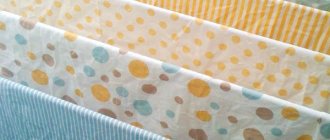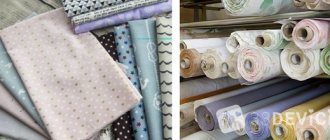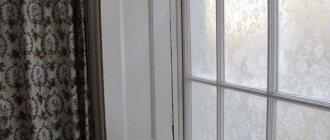Answer or solution 2
How to make fabric at home.
MANUFACTURING OF FABRICS. It was carried out on a vertical weaving loom (loom). In addition to this, various devices were required: planks and reeds - combs with fine teeth. In Rus', several methods of weaving threads were used, which can be combined into three groups: complex weave, twill and plain. Based on the quality of the fabrics, they were divided into thin, medium and hard. After the fabric was ready, various clothes were sewn from it, and this is an equally complex and time-consuming process. Therefore, in the past it was changed less often and was valued more than it is now. The flax fabric we talked about was used to make shirts, underwear and towels. Outerwear was made from woolen fabrics - various types of cloth. It was usually painted black, blue, green, yellow, red and white.
Clothing has always played an important role in the culture of the people of all countries of the world. One type of natural ancient fabric for clothing is linen fabric. The flax was collected, dried and laid out on the grass. After a few weeks, the fibers separated from the stem. They were combed and divided into strips (rovings). After this, the rovings were twisted in a spiral by hand or with a spindle on a spinning wheel and formed into yarn. Animal wool (sheep, foxes, rabbits and others) was used to make woolen clothing.
Man mastered the process of making fabrics many centuries ago and has been constantly improving this technique since then. However, returning to the roots makes you want to try to master making fabric yourself at home.
Nettle fabric
Nettle yarn is made by separating plant fibers from the hard part of the stem. In order to make this process as easy as possible, nettle stems should be collected in early spring after the snow has melted. Overwintered nettle has a brown-brown color and there are practically no leaves on the stems. The collected stems, cleared of debris, must be dried on a stove or near a radiator. This process will take about two weeks, after which you can proceed to making yarn.
- Using a beater (a wooden device with a fixed lever for beating), the nettle stems need to be thoroughly kneaded;
- To remove the woody parts of the stem from crushed nettles, they need to be frayed. To do this, the stems are beaten with a wooden beater. During the scutching process, the smallest particles of stems are easily removed;
- Using special tongs from birch planks, you need to scrub - remove solid particles between the upper fibers;
- After cleaning the fibers, they begin carding - separating the fibers depending on their length. The longest fibers - tow - are used to make yarn;
- To obtain yarn you will need a spinning wheel; modern models with a foot drive are very convenient;
- The resulting yarn is woven into fabric using a home loom. The simplest weaving is alternating weft and warp threads, the fabric is dense and monochromatic.
Patterns
- Patterns are made from cardboard. To do this, draw two squares on cardboard. The first square should be 4 times larger than the second. The allowances are 5 mm in size.
- The textile square is folded with the edges toward the center and then ironed.
- The internal space is filled with padding polyester. The corners are fixed with pins.
- The workpiece is turned over and another square is placed in its center. After which the corners of the larger square are again collected in the center so that the small square is inside the other.
- The corners gathered in the center are sewn together in such a way that the hole is not completely sewn up. The pins are then removed.
- The lapels should be folded back and secured with pins. After which they are stitched.
- An additional decorative element can be a button sewn in the center.
If you have any difficulties with your work, you should familiarize yourself with photo and video master classes on making fabric crafts posted on the Internet.
Linen fabric
If you want to make your own fabric from flax, the process is largely similar to that described above:
- The collected flax stems must be soaked and thoroughly dried;
- Next, the material needs to be kneaded and frayed. Thus, fiber separation occurs. A special composition is sold for separating hard, medium-hard and soft raw materials for bleaching;
- With the help of a spinning wheel, yarn is obtained from the stems; individual fibers are combined into a thread, from which fabric will then be obtained;
- The yarn is then turned into fabric on a loom.
Crafts for gifts
Thus, using the methods described above, seemingly useless scraps of fabric are transformed into exclusive crafts that the author can rightfully be proud of.
Note!
Corrugated paper flowers: TOP 100 photos of ready-made options + instructions on how to make them yourselfDIY family tree: instructions for creating a family tree + DIY design ideas
Do-it-yourself sun lounger: photos with instructions for creating sun loungers + detailed diagrams of the stages of work
These include New Year's crafts made from fabric, gifts for March 8 and Defender of the Fatherland Day. Even preschool children can make most crafts.
Wool fabric
The fabric obtained from the wool and down of domestic animals is very warm, has healing properties and is very highly prized. The wool of sheep, goats, camel and even dog hair (fluff) is suitable for work.
- Primary processing includes separating clean wool suitable for work from hard hairs and foreign debris;
- The prepared wool is combed several times, thus forming a tow - the material for producing yarn;
- Yarn is spun from tow. The resulting thread can be twisted in half to obtain greater thickness;
- Woolen fabric is produced from wool threads on a loom. The more thorough preparation the wool undergoes at the initial stage, the higher its quality will be.
Thread fabric
In order to make fabric from threads, you can go in two ways.
- Traditionally, long warp threads are placed on the loom and gradually interwoven into the weft fabrics. Depending on the color of the threads, you can get a plain fabric or with patterns, it all depends on your imagination.
- An easier method that does not require special equipment: yarn is placed in a mosquito net folded in half. It is necessary to steam the mesh with yarn with an iron, and then coat it thoroughly with glue. After the glue has dried, the mesh is removed, the resulting fabric is stitched lengthwise and crosswise on a sewing machine, at intervals of 2 cm, and then washed to remove any remaining glue. The thickness of the fabric depends on the properties of the yarn.
With a little effort you will end up with a great looking fabric.
October 30, 2018
We tell and show how to wax fabric at home.
Waxed cotton is useful in everyday life because it becomes waterproof, and can be used repeatedly; simply wipe with a damp cloth or rinse under running cold water.
That's why housewives use it for food packaging, for example, to make sandwich bags, covers for utensils, or simply to wrap food.
Rugs made from pieces of fabric
Fabric scraps can be used to create soft rugs for the bathroom, hallway, bedroom, etc. You don’t need to have any skills to do this – anyone can do this kind of work. Rugs can be made plain or colored, round, rectangular or square, the ribbons in them can be placed randomly or create a specific pattern - it all depends on the fabrics you have and your desire.
To create a rug from scraps you will need:
- strips of fabric;
- plastic mesh (the most affordable option is construction mesh) with square cells, the most convenient cell size is 10x10 mm.
Cut the fabric into strips 10-15 cm long. The width of the strip depends on the density of the fabric: if you have thin knitwear, then make it 5 cm wide, and if you decide to use leftovers from a thick terry robe, then 2 cm is enough.
To create rugs, it is better to use non-friable, slightly stretchable fabrics; the ideal option is old knitted T-shirts.
After the strips are cut, get to work:
- Cut a piece of the desired length and width from the mesh: add 3-5 cm to the desired size of the rug on all four sides.
- Tuck the edges of the mesh (3-5 cm) inward along the perimeter. They need to be fixed so that the mesh does not fray over time. To do this, tightly cover the rug around the edges with a long strip of fabric (photo 1 in the collage).
- Proceed to the main part of the work. Your goal is to secure the strips in the cells (you need to move from the edges of the mat to the center). This can be done in two ways: either tie regular knots (photo 2), or make a fastening with a lock, which is used in macrame (photo 3).
If you don't have a mesh, you can use matting or burlap instead (photo 4). However, in this case, it is better to take thin fabric for the stripes and pull it through the holes not with your hands, but with a crochet hook.










